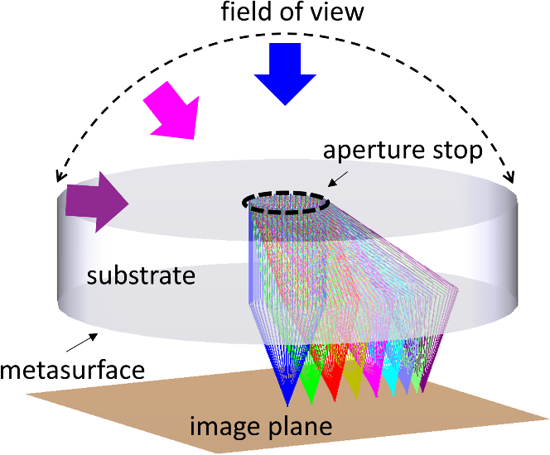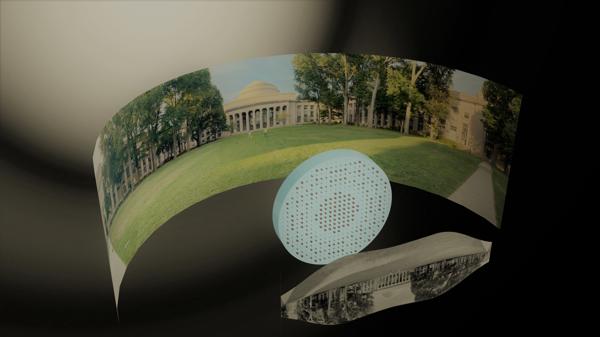Field-of-view (FOV) is a critical performance metric for optics and optical systems. Wide FOV optics are widely used in machine vision, augmented/virtual reality (AR/VR), automotive sensing, robotic sensing, biomedical imaging, security surveillance, and more. Conventional wide FOV optics, exemplified by the so-called 'fisheye lenses', involve cascading multiple refractive optical elements to mitigate off-axis aberrations. As a result, for a long time wide-FOV optics have been synonymous with bulky and complicated multi-lens assembly. The compound optics configuration increases the size, weight, cost, and complexity of these optics, severely curtailing their practical deployment.
The challenges associated with traditional wide FOV optics can be overcome by making use of optical metasurfaces, which are planar artificial media comprising arrays of sub-wavelength antennas (also called "meta-atoms"). The research group led by Dr. Tian Gu and Prof. Juejun Hu at MIT recently proposed, for the first time, a wide FOV metasurface lens (metalens) design, which transforms a flat piece of glass into an ultra-compact 'fisheye' lens featuring near-180° FOV, diffraction-limited quality, high optical efficiency and a remarkably simple single-layer metasurface configuration. The metalens design is schematically illustrated in Fig. 1, which comprises a single piece of flat transparent substrate with an input aperture positioned on the front surface and a metasurface positioned on the back surface. Light beams of different angles of incidence are refracted by the front surface to the backside metasurface and then focused onto a flat image plane. However, The metalens was designed via numerical optimization, which is not only computationally involved but also limits the further exploration of extensive design parameter space.

Fig. 1. Schematic design of the flat fisheye lens with panoramic FOV
The research group led by Dr. Tian Gu and Prof. Juejun Hu at MIT recently proposed an analytical formalism to the wide-FOV metalens design, providing a closed-form solution to the metasurface phase function in these lenses. The research results published in Chinese Optics Letters , Volume 21, Issues. 2, 2023 (F. Yang et al. Understanding wide field-of-view flat lenses: an analytical solution [Invited]) .
The result is significant in two ways. It drastically simplifies the design flow of wide-FOV metasurface optics, reducing the design iteration down to a few hours or even less. The much lower computational load also enables extensive parameter search to quantify the design trade-offs, which would otherwise become excessively time consuming and laborious. More importantly, Yang et al. further applied their approach to analyze the optical quality of the lens design, thereby elucidating several important insights into wide-FOV flat lenses. For example, their analysis elegantly reveals that optimal imaging quality can be achieved with so-called 'telecentric' configuration, which has been previously adopted in empirical large FOV metalens designs but hitherto lacking a rigorous theoretical justification.

Fig. 2. Artistic rendering of panoramic imaging via a wide FOV metalens
This result will have broad impact on a wide array of practical applications. The examples include 3-D depth sensing, where wide FOV is an essential feature for many use cases such as AR/VR, where a wide FOV and imaging quality matching that of human vision is necessary to render an immersive user experience. Similar to 3-D sensing, wide FOV, high resolution, and compact form factor, which are key characteristics of the reported design, are also highly coveted features in minimally invasive or point-of-care biomedical imaging. The technology is also promising for wide FOV video surveillance systems deployed in various fields, such as driver monitoring system, eye tracking, biometric identification, security surveillance, and so on. We will likely witness commercial deployment of wide FOV flat optics over the next few years to come, where the analytical design will play a pivotal role in expediting and expanding the technology adoption.


